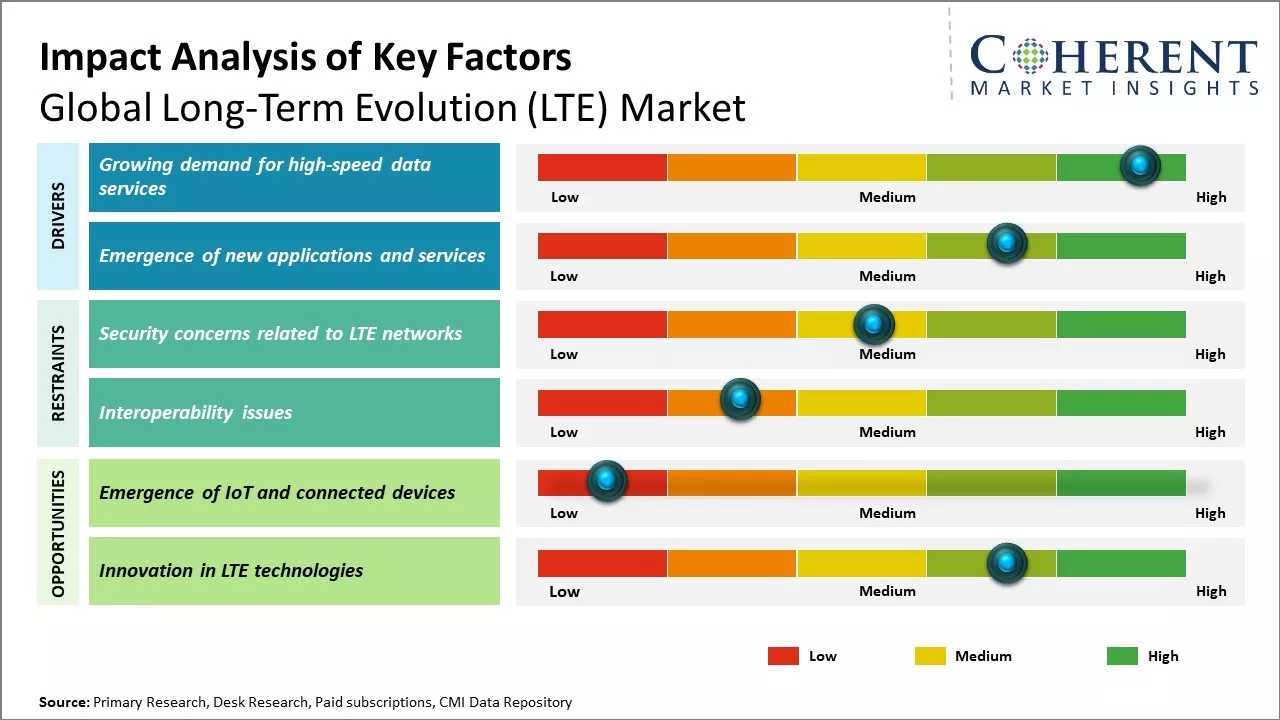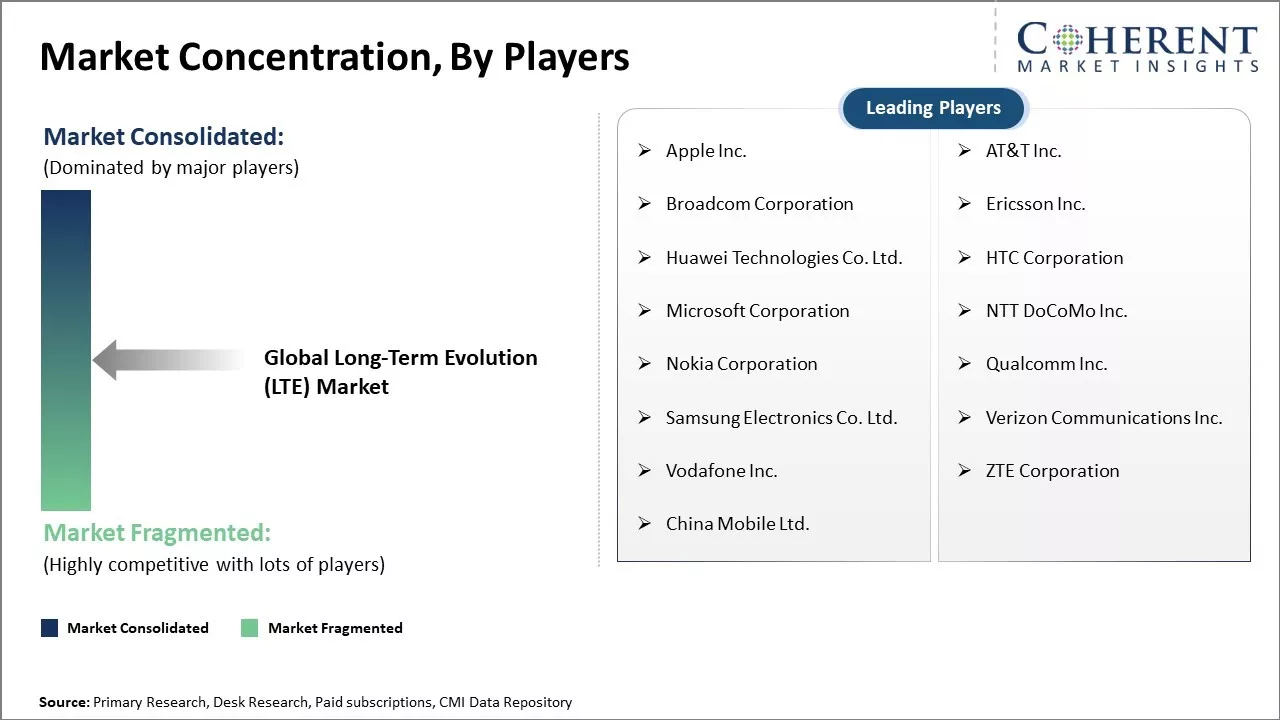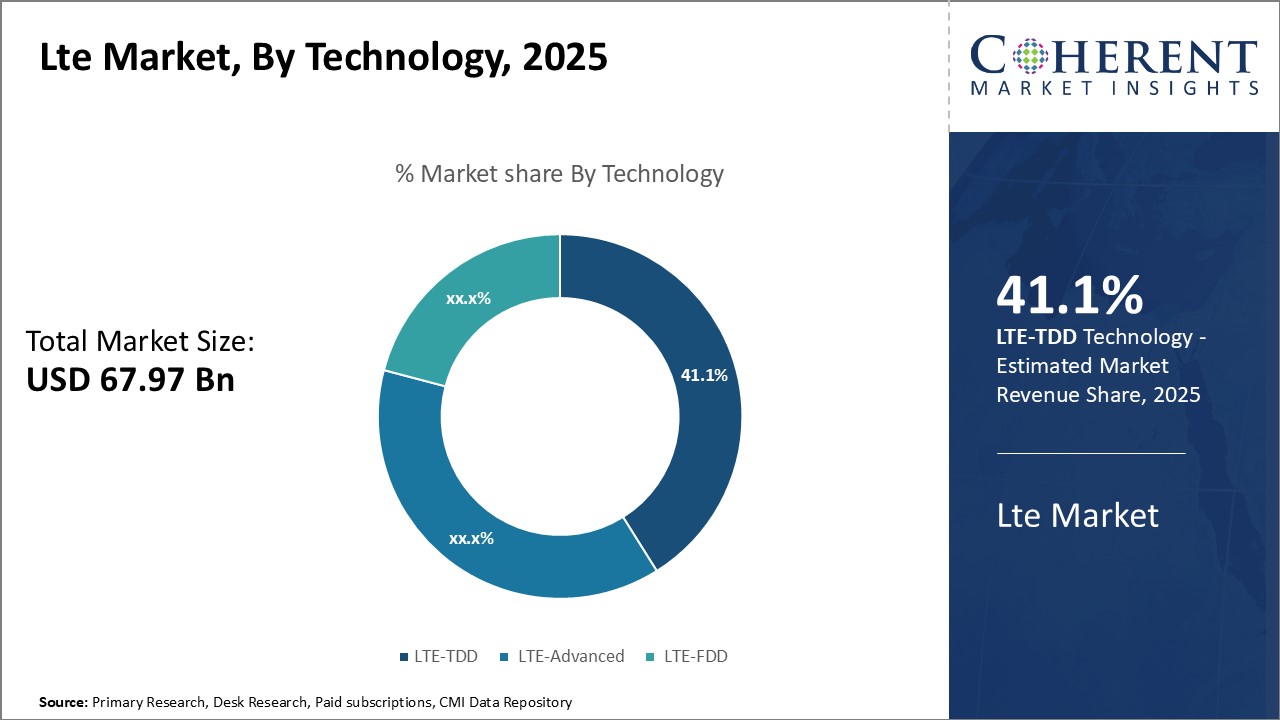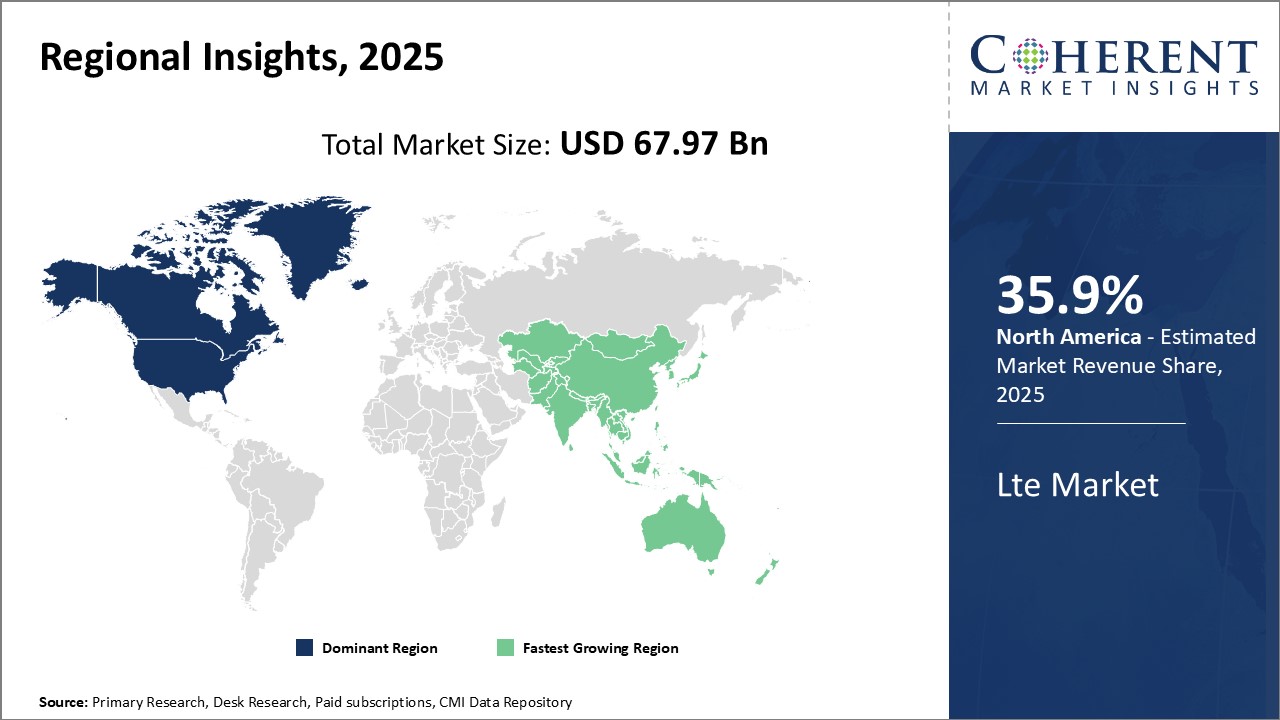The global Long-Term Evolution (LTE) market is estimated to be valued at US$ 67.97 Bn in 2025 and is expected to reach US$ 265.84 Bn by 2032, exhibiting a compound annual growth rate (CAGR) of 21.5% from 2025 to 2032.

Discover market dynamics shaping the industry: Download Free Sample
The market is expected to witness significant growth during the forecast period. The growth can be attributed to the rising adoption of advanced networking technologies by businesses across industries for enabling digital transformation. LTE technology allows seamless connectivity and faster data transfer which is now considered indispensable for the deployment of technologies like Internet of Things (IoT), edge computing, and mobiles apps. Further, the increasing demand for enhanced broadband speeds and coverage internationally is also boosting investments in the LTE infrastructure. Upcoming technologies like 5G network are anticipated to further propel the demand. Although spectrum constraints and high capital expenditure pose challenges, overall, the outlook for the global Long-Term Evolution (LTE) Market remains positive.
Growing demand for high-speed data services
The growing demand for high-speed data services is one of the key drivers behind the growth of the global Long-Term Evolution (LTE) Market. With the proliferation of smart devices such as smartphones, tablets, and other connected devices, data consumption has seen a massive surge over the past few years. People are increasingly streaming high-definition videos, playing graphics-intensive games, using GPS navigation and maps, video chatting with friends and family, and others - all of which require high-speed connectivity. Traditional 3G networks are unable to support the bandwidth and latency requirements of such data-hungry applications. This growing demand for rich multimedia experiences on mobile devices anywhere and anytime is propelling mobile operators across the world to upgrade their networks to high-speed LTE technology. The capabilities of LTE such as higher spectrum efficiencies, network flexibility, and lower deployment costs make it the ideal technology to deliver high-speed connectivity and enriched services to consumers and enterprises.
For instance, in February 2020, Ethio Telecom, an Ethiopian telecommunication company serving as the major internet and telephone service provider announced the launch of its state-of-the-art LTE advanced mobile internet service, which aimed to expand the existing limited LTE network coverage to meet the growing customer demands across regional cities. This new service is designed to enhance customer experience by providing reliable connections with exceptional data speeds, enabling seamless downloading and uploading, high-quality live streaming, and real-time video conferencing.

Get actionable strategies to beat competition: Download Free Sample
Emergence of new applications and services
The emergence of new applications and services fueled by technologies like artificial intelligence, augmented/virtual reality, and Internet of Things is another key factor expected to significantly drive the Long-Term Evolution (LTE) Market during the forecast period. From advanced Virtual reality (VR) and augmented reality (AR) applications with massive data requirements to mission-critical IoT platforms demanding ultra-low latency connectivity, the future applications landscape will put immense pressure on current network infrastructures. LTE with its advanced capabilities provides the robust framework required to power these new-age services. For instance, IoT networks integrated with LTE can deliver broader coverage, better performance, easier deployment, and lower costs. Similarly, technologies like Artificial intelligence and augmented reality demand high bandwidth and low latency which LTE excels in delivering. As a result, mobile operators are vigorously deploying LTE networks to capitalize on the market opportunities arising from the new digital ecosystems of tomorrow. The transformation of industries through connected IoT applications and experience-rich immersive technologies will sustain the high growth momentum of the Long-Term Evolution (LTE) Market.
Key Takeaways from Analyst:
The global Long-Term Evolution (LTE) Market continues to experience strong growth driven by increasing mobile data consumption globally. Rising demand for high-speed internet on mobile devices for activities like video streaming, social networking and online gaming is a major factor driving more consumers and businesses to adopt 4G LTE networks. However, the market still faces some restraints from challenges in deploying extensive LTE infrastructure in developing regions with sparse populations and difficult terrains.
North America is expected to remain leading regions for LTE due to high mobile penetration and strong consumer migration towards premium data plans. However, emerging Asia Pacific markets like China and India are likely to increasingly contribute to market expansion in the coming years supported by conducive government policies and initiatives for telecom infrastructure development in these countries.
New technologies such as IoT, autonomous vehicles, augmented reality, and 5G are expected to further stimulate the LTE growth by increasing connected devices and requiring low-latency connectivity. Nonetheless, the transition to 5G standalone systems from non-standalone 5G architecture may slow down the LTE growth rate in the long run. Operators will need to manage network migration judiciously to maximize returns on existing LTE infrastructure investments.
Market Challenges: Security concerns related to LTE networks
Security concerns have become a major restraint in the growth of the global Long-Term Evolution (LTE) Market. As LTE networks are Internet Protocol (IP)-based, they are more prone to cyber-attacks and security threats compared to earlier generation cellular networks. As sensitive user data and financial transactions are being carried through these networks, protecting the network infrastructure and user privacy has become a big challenge. Several security exploits have been reported on the 4G LTE networks in the recent past that raised serious concerns about network vulnerabilities and potential data leaks.
Many operators are still unable to fully mitigate security risks and address vulnerabilities at different layers of the LTE network. As attacks are evolving rapidly with new techniques, operators struggle to plug security holes on a continuous basis. This has increased infrastructure costs significantly for operators to deploy advanced security safeguards like encryption, authentication and regular software updates. The need to ensure strict privacy regulations like Europe's GDPR has also pushed up compliance expenditure. High security management costs have made network upgrades and expansions less commercially attractive for operators, especially in cost-sensitive developing markets. Unless these security challenges are addressed comprehensively, consumer fears of data thefts are likely to hold back the growth of LTE subscriptions and usage over the coming years.
Market Opportunities: Emergence of IoT and connected devices
The emergence of Internet of Things (IoT) and connected devices brings tremendous opportunities for the global Long-Term Evolution (LTE) market. With more things getting connected through the internet, the amount of data exchange is expected to explode exponentially in the coming years. This is where LTE comes into the picture. Being a faster and more efficient wireless standard compared to 3G, LTE is well-placed to support the rising data demands created by billions of new IoT connections.
To summarize, the continued advancement of IoT technologies and their growing real-world implementations across industry verticals presents a major growth driver for LTE over the next few years. As networks support more IoT connections transmitting larger amounts of data, global LTE subscriptions and traffic are slated to rise significantly according to forecasts by impartial organizations like GSMA. This emerging trajectory clearly portends favorable prospects for stakeholders in the Long-Term Evolution (LTE) Market space.

Discover high revenue pocket segments and roadmap to it: Download Free Sample
Insights By Technology: LTE-TDD Dominates Due to Infrastructure Compatibility
The LTE-TDD segment is expected to capture 41.1% share in 2025 in the global Long-Term Evolution (LTE) Market in terms of technology. One primary reason for its dominance is infrastructure compatibility. LTE-TDD utilizes the same core network infrastructure as FDD, allowing mobile operators to reuse existing fiber backbone and core networks. This provides a significant capital expenditure advantage over building new dedicated infrastructure for alternative technologies. LTE-TDD compatibility with existing infrastructure means that mobile operators do not need to completely overhaul their networks when deploying new TDD-based cellular technology.
In addition, the ability of LTE-TDD to leverage current infrastructure helps accelerate its adoption across both suburban and rural regions. Rollout of dedicated new technology often focuses initially only on dense urban population centers due to high costs. However, by building upon established fiber and core assets, LTE-TDD can be deployed more quickly and cost-effectively into lower density areas. This broader geographic coverage further expands the addressable market and userbase for LTE-TDD applications over time.
The infrastructure compatibility of LTE-TDD has also facilitated cooperation among mobile operators. Network sharing agreements allow multiple carriers to utilize common wireless infrastructure like cell towers and backhaul links. By supporting these multi-operator models, LTE-TDD enables improved rural coverage through joint deployment while reducing expenditure versus independent operator builds. Its reuse of existing network resources lowers barriers for operators to partner on expansions, strengthening LTE-TDD proliferation.
Insights By Application: Video on Demand Drives Through Mobility
Within the global Long-Term Evolution (LTE) Market segmented by application, video on demand is expected to capture 39.8% share in 2025. A major factor propelling the Video on Demand segment resides in its ability to enable highly mobile content consumption. As data speeds and capacities continue rising with advancements in LTE technologies like TDD and carrier aggregation, users increasingly expect on-the-go access to streaming video. With LTE networks, Video on Demand services can seamlessly deliver content to various devices beyond traditional fixed locations.
High quality video streaming is also compelling many users who consume large amounts of online content to shift from WiFi networks to cellular-based access. LTE networks facilitate continuous viewing of favored shows, movies or live sports across different environment settings whether indoor, outdoor or in-transit. The consistent high-speed connectivity of LTE allows users to maintain seamless access to Video on Demand libraries anywhere within coverage areas.
Additionally, LTE is opening new frontiers for video engagement through innovative adaptive streaming formats. Technologies such as DASH enable higher resolution playback optimized in real-time for available bandwidth conditions. Users directly experience improved video resolution matching fluctuations in their internet speeds, whether on low or high-capacity LTE connections. Such advancements continually enhance the mobile Video on Demand experience and further drive users to access more video content via LTE networks.

Need a Different Region or Segment? Download Free Sample
North America has emerged as the dominant region in the global Long-Term Evolution (LTE) Market with 35.9% share in 2025. The early and widespread adoption of 4G networks across major markets like the U.S. and Canada has provided North American mobile carriers and technology firms a significant head starts over other regions. Further, the presence of leading network equipment providers and smartphone manufacturers in the region has helped drive the growth and rollout of LTE infrastructure at a rapid pace. Many North American telecom operators have essentially completed transitioning their network to LTE coverage nationwide, allowing them to focus on more advanced services and capabilities.
Asia Pacific, on the other hand, is expected to witness the fastest growth in the Long-Term Evolution (LTE) Market over the coming years. Several factors make the region primed for robust expansion, such as growing consumer demand for high-speed mobile broadband services, especially in large and populous markets like China and India. Mobile subscribers in the region have also demonstrated a strong preference for newer smartphone models and apps suited for 4G networks. Additionally, countries in Asia Pacific are prioritizing investments to develop their digital infrastructure and economies. This has prompted telecom regulators to encourage the widespread rollout of LTE by operators through policy support mechanisms. As a result, global telecom equipment suppliers have been expanding their footprint rapidly across Asia to capitalize on the surging investments.
What gives North America an edge is the stable policy environment that paved the way for an early rollout of commercial LTE deployments since 2010. However, the market is reaching saturation with operators focusing on more advanced technologies going forward. For Asia Pacific, the LTE adoption is still in its initial growth phase with majority of the networks currently in the development or rollout stage across markets. While lacking a unified regulator, local country-level policies are strongly aligned to digitize their economies through connectivity projects. This positions Asia Pacific as the most lucrative near-term market for stakeholders during the prime growth years of LTE.
Lte Market Report Coverage
| Report Coverage | Details | ||
|---|---|---|---|
| Base Year: | 2024 | Market Size in 2025: | USD 67.97 Bn |
| Historical Data for: | 2020 To 2024 | Forecast Period: | 2025 To 2032 |
| Forecast Period 2025 to 2032 CAGR: | 21.5% | 2032 Value Projection: | USD 265.84 Bn |
| Geographies covered: |
|
||
| Segments covered: |
|
||
| Companies covered: |
Apple Inc., AT&T Inc., Broadcom Corporation, Ericsson Inc., Huawei Technologies Co. Ltd., HTC Corporation, Microsoft Corporation, NTT DoCoMo Inc., Nokia Corporation, Qualcomm Inc., Samsung Electronics Co. Ltd., Verizon Communications Inc., Vodafone Inc., ZTE Corporation, and China Mobile Ltd. |
||
| Growth Drivers: |
|
||
| Restraints & Challenges: |
|
||
Uncover macros and micros vetted on 75+ parameters: Get instant access to report
*Definition: The global Long-Term Evolution (LTE) market provides advanced wireless broadband services for mobile devices such as smartphones, laptops connected via dongles, tablets, and netbooks. LTE enables significantly faster data transfer speeds and response times from mobile networks compared to 3G technologies. It provides carriers with more efficient use of their frequency resources to meet the growing mobile broadband demands, which are being driven by the increasing data consumption of innovative new applications and services. LTE allows high-speed data transfer over broadband networks to support real-time multimedia applications and improve mobile Internet connectivity for smartphones and wireless data devices.
Share
Share
About Author
Monica Shevgan has 9+ years of experience in market research and business consulting driving client-centric product delivery of the Information and Communication Technology (ICT) team, enhancing client experiences, and shaping business strategy for optimal outcomes. Passionate about client success.
Missing comfort of reading report in your local language? Find your preferred language :
Transform your Strategy with Exclusive Trending Reports :
Frequently Asked Questions
Joining thousands of companies around the world committed to making the Excellent Business Solutions.
View All Our Clients